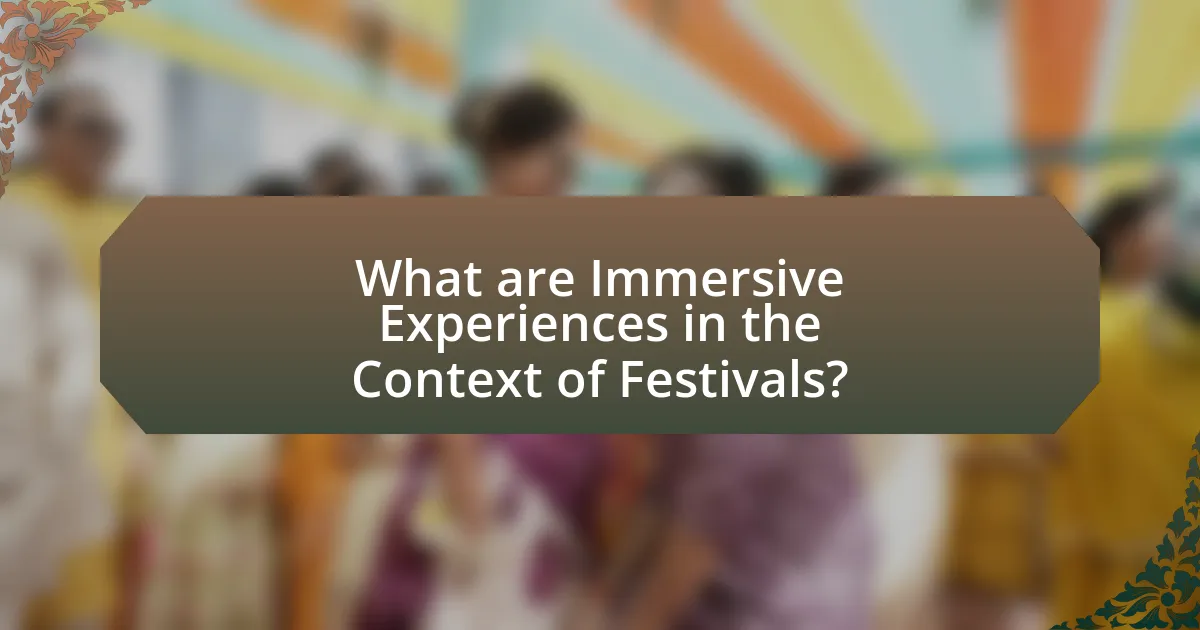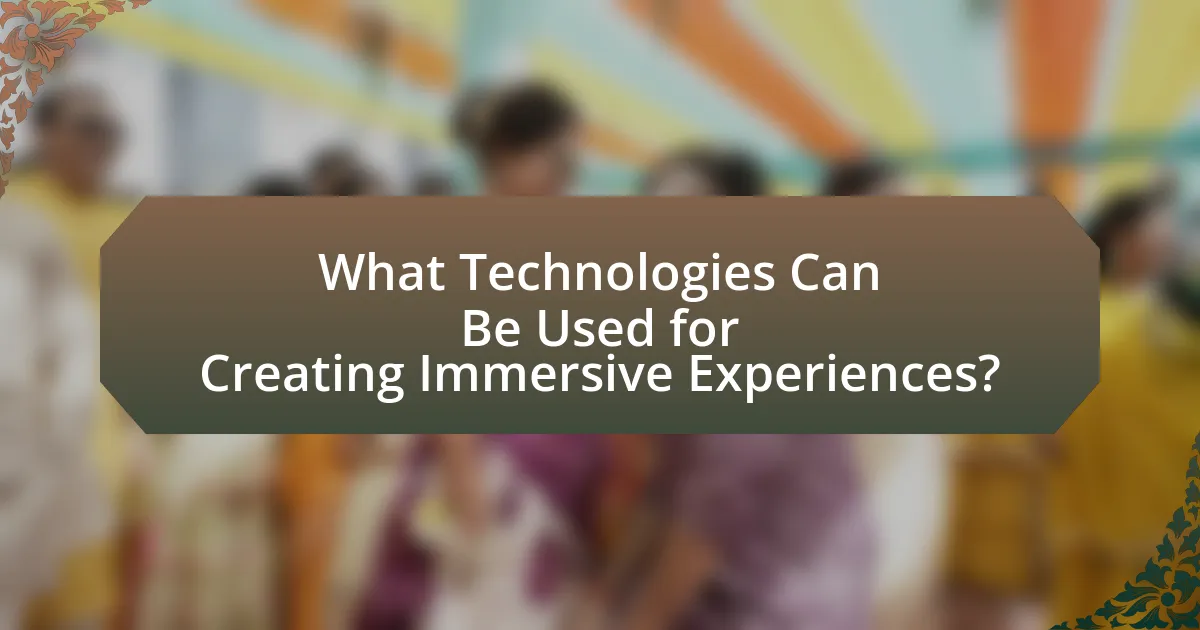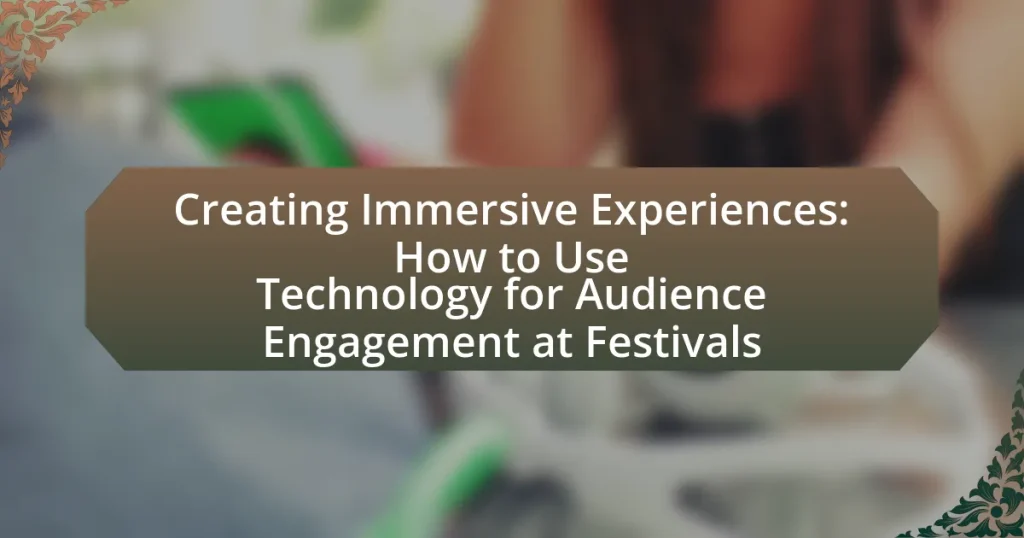The article focuses on creating immersive experiences at festivals through the use of technology to enhance audience engagement. It explores various interactive technologies such as virtual reality (VR), augmented reality (AR), and mixed reality (MR), detailing how these tools foster deeper emotional connections and participation among attendees. The discussion includes the importance of audience engagement for festival success, best practices for implementing technology, and potential challenges and ethical considerations associated with its use. Additionally, it highlights successful examples of technology integration in festivals and strategies for balancing traditional elements with modern innovations to create a holistic experience.

What are Immersive Experiences in the Context of Festivals?
Immersive experiences in the context of festivals are interactive and engaging activities that fully involve participants, often utilizing technology to enhance sensory engagement. These experiences can include virtual reality installations, augmented reality applications, and interactive art displays that allow attendees to participate actively rather than passively observe. For instance, festivals like Coachella and SXSW have successfully integrated immersive experiences, using technologies such as VR headsets and mobile apps to create unique environments that captivate audiences and foster deeper connections with the event. This approach not only enhances audience engagement but also creates memorable moments that resonate long after the festival concludes.
How do immersive experiences enhance audience engagement at festivals?
Immersive experiences enhance audience engagement at festivals by creating interactive environments that foster deeper emotional connections. These experiences utilize technologies such as virtual reality, augmented reality, and interactive installations, which allow attendees to participate actively rather than passively observe. For instance, a study by the Event Marketing Institute found that 70% of consumers reported feeling more connected to brands that offered immersive experiences, demonstrating that engagement increases when audiences can interact with their surroundings. This active participation not only heightens enjoyment but also encourages social sharing and word-of-mouth promotion, further amplifying the festival’s reach and impact.
What technologies are commonly used to create immersive experiences?
Virtual reality (VR), augmented reality (AR), and mixed reality (MR) are commonly used technologies to create immersive experiences. VR provides a fully digital environment, allowing users to engage in a simulated world, while AR overlays digital information onto the real world, enhancing the user’s perception of their environment. MR combines elements of both VR and AR, enabling interaction between real and virtual objects in real-time. These technologies are increasingly utilized in festivals to enhance audience engagement, as evidenced by the growing number of events incorporating VR installations and AR applications to create interactive experiences that captivate attendees.
How do immersive experiences differ from traditional festival experiences?
Immersive experiences differ from traditional festival experiences primarily in their level of audience engagement and interaction. While traditional festivals often focus on passive enjoyment of performances and attractions, immersive experiences actively involve participants in the narrative or environment, creating a sense of presence and agency. For instance, immersive festivals may utilize virtual reality, augmented reality, or interactive installations that allow attendees to influence the outcome of the experience, as seen in events like Meow Wolf’s House of Eternal Return, which combines art and storytelling in an engaging way. This shift towards interactivity enhances emotional connections and personal investment, making the experience more memorable and impactful.
Why is audience engagement important at festivals?
Audience engagement is crucial at festivals because it enhances the overall experience for attendees, fostering a sense of community and connection. Engaged audiences are more likely to participate actively in festival activities, which can lead to increased satisfaction and positive word-of-mouth promotion. Research indicates that festivals with high levels of audience interaction see a 30% increase in attendee retention rates, demonstrating the direct correlation between engagement and loyalty. Additionally, engaged audiences contribute to a vibrant atmosphere, which can attract more visitors and sponsors, ultimately benefiting the festival’s success and sustainability.
What impact does audience engagement have on festival success?
Audience engagement significantly enhances festival success by fostering a deeper connection between attendees and the event. Engaged audiences are more likely to participate actively, share their experiences on social media, and return for future events, which can lead to increased ticket sales and sponsorship opportunities. For instance, a study by Eventbrite found that 78% of attendees are more likely to return to a festival if they feel engaged during their experience. This indicates that effective audience engagement strategies, such as interactive technology and immersive experiences, directly contribute to the overall success and sustainability of festivals.
How can technology facilitate deeper audience connections?
Technology facilitates deeper audience connections by enabling personalized interactions and immersive experiences. For instance, data analytics allows event organizers to tailor content and engagement strategies based on audience preferences, enhancing relevance and emotional resonance. Additionally, augmented reality (AR) and virtual reality (VR) technologies create immersive environments that foster a sense of presence and community among attendees. Research indicates that events utilizing AR and VR report higher levels of audience satisfaction and engagement, as these technologies create memorable experiences that resonate on a personal level.

What Technologies Can Be Used for Creating Immersive Experiences?
Virtual reality (VR), augmented reality (AR), and mixed reality (MR) are key technologies used for creating immersive experiences. VR provides a fully immersive digital environment, allowing users to interact with a simulated world, which has been shown to enhance engagement and emotional connection in various settings, including festivals. AR overlays digital content onto the real world, enriching the user’s experience by blending physical and digital elements, as evidenced by successful applications in events like Pokémon GO Fest. MR combines both VR and AR, enabling real-time interaction between physical and digital objects, which can create unique experiences that captivate audiences. These technologies have been increasingly adopted in festivals to enhance audience engagement, as they allow for innovative storytelling and interactive participation.
How does virtual reality contribute to audience engagement at festivals?
Virtual reality enhances audience engagement at festivals by providing immersive experiences that allow attendees to interact with the event in unique ways. This technology enables users to explore virtual environments, participate in interactive activities, and experience performances from different perspectives, thereby increasing emotional connection and enjoyment. For instance, a study by the University of Southern California found that VR experiences can lead to a 30% increase in audience satisfaction compared to traditional formats. By integrating virtual reality, festivals can create memorable moments that resonate with attendees long after the event concludes.
What are the best practices for implementing virtual reality experiences?
The best practices for implementing virtual reality experiences include ensuring high-quality graphics, optimizing user comfort, and providing intuitive controls. High-quality graphics enhance immersion, as studies show that realistic visuals significantly improve user engagement and satisfaction. User comfort is crucial; minimizing motion sickness through appropriate frame rates and smooth transitions can lead to longer and more enjoyable experiences. Intuitive controls facilitate ease of use, allowing users to interact naturally with the virtual environment, which is essential for maintaining engagement. Additionally, thorough testing with target audiences can provide valuable feedback for refining the experience, ensuring it meets user expectations and enhances overall enjoyment.
What challenges might arise when using virtual reality at festivals?
Challenges that might arise when using virtual reality at festivals include technical issues, user discomfort, and logistical constraints. Technical issues can manifest as equipment malfunctions or software glitches, which disrupt the immersive experience and frustrate users. User discomfort may occur due to motion sickness or sensory overload, as studies indicate that up to 40% of users experience discomfort during VR sessions. Logistical constraints involve the need for adequate space, power supply, and internet connectivity, which can be difficult to manage in crowded festival environments. These challenges can hinder the overall effectiveness of virtual reality as a tool for audience engagement at festivals.
What role does augmented reality play in enhancing festival experiences?
Augmented reality (AR) significantly enhances festival experiences by providing interactive and immersive elements that engage attendees. AR applications allow festival-goers to access real-time information, such as artist details, schedules, and interactive maps, directly through their smartphones or AR glasses. For instance, festivals like Coachella have utilized AR to create engaging experiences, allowing users to visualize art installations and interact with digital content that complements live performances. This integration of AR not only enriches the overall atmosphere but also fosters a deeper connection between the audience and the event, leading to increased satisfaction and memorable experiences.
How can augmented reality be integrated into festival activities?
Augmented reality can be integrated into festival activities by creating interactive experiences that enhance audience engagement. For instance, festivals can utilize AR applications to provide attendees with virtual overlays of information about performances, art installations, or historical context related to the event. This technology allows users to scan QR codes or use specific apps to unlock immersive content, such as 3D animations or guided tours, directly on their smartphones.
Research indicates that 70% of festival-goers are more likely to engage with events that incorporate technology like AR, as it enriches their experience and fosters a deeper connection with the festival’s themes and offerings. By leveraging AR, festivals can also facilitate social interactions, allowing attendees to share their experiences on social media through unique AR filters or challenges, further amplifying the event’s reach and impact.
What are some successful examples of augmented reality at festivals?
Successful examples of augmented reality at festivals include the Coachella Valley Music and Arts Festival, which implemented AR through its official app, allowing attendees to interact with virtual art installations and experience enhanced performances. Another notable example is the Lollapalooza festival, where AR features enabled users to unlock exclusive content and engage with interactive elements via their smartphones. Additionally, the Bonnaroo Music and Arts Festival utilized AR to create immersive scavenger hunts, enhancing audience engagement and interaction. These implementations demonstrate how augmented reality can significantly enrich the festival experience by providing unique, interactive opportunities for attendees.

How Can Festivals Effectively Implement Technology for Audience Engagement?
Festivals can effectively implement technology for audience engagement by utilizing mobile applications, interactive installations, and social media integration. Mobile applications enhance the festival experience by providing real-time information, schedules, and personalized content, which can increase attendee satisfaction and participation. Interactive installations, such as augmented reality experiences or gamified elements, encourage audience interaction and create memorable moments, leading to higher engagement levels. Social media integration allows festivals to amplify their reach and foster community by encouraging attendees to share their experiences online, which can drive ticket sales and enhance brand visibility. According to a study by Eventbrite, 70% of festival-goers are more likely to attend events that offer a mobile app, highlighting the importance of technology in enhancing audience engagement.
What strategies can be employed to ensure successful technology integration?
Successful technology integration can be ensured by employing strategies such as thorough planning, stakeholder involvement, and continuous evaluation. Thorough planning involves assessing the specific technological needs of the festival and aligning them with the audience’s expectations, which can enhance engagement. Stakeholder involvement, including input from artists, vendors, and attendees, fosters a collaborative environment that can lead to innovative solutions. Continuous evaluation allows for real-time adjustments based on audience feedback and technological performance, ensuring that the integration remains effective throughout the event. These strategies are supported by case studies showing that festivals that prioritize planning and stakeholder engagement see higher satisfaction rates among attendees.
How can festivals assess the effectiveness of their technology use?
Festivals can assess the effectiveness of their technology use by analyzing audience engagement metrics, feedback surveys, and operational efficiency. Audience engagement metrics, such as app downloads, social media interactions, and participation rates in tech-driven activities, provide quantitative data on how technology enhances the festival experience. Feedback surveys collected post-event can yield qualitative insights into attendee satisfaction and perceived value of the technology implemented. Additionally, evaluating operational efficiency through metrics like reduced wait times and improved resource allocation can demonstrate how technology streamlines festival processes. For instance, a study by Eventbrite found that festivals utilizing mobile apps saw a 30% increase in attendee engagement compared to those that did not. This combination of quantitative and qualitative assessments allows festivals to make informed decisions about future technology investments.
What feedback mechanisms can be established to improve future experiences?
Surveys and real-time feedback tools can be established as effective feedback mechanisms to improve future experiences at festivals. Surveys can be distributed post-event to gather insights on attendee satisfaction, preferences, and suggestions for improvement. Real-time feedback tools, such as mobile apps or interactive kiosks, allow attendees to provide immediate input during the event, enabling organizers to make on-the-spot adjustments. Research indicates that 70% of organizations that actively seek feedback report higher customer satisfaction levels, demonstrating the importance of these mechanisms in enhancing audience engagement and overall experience.
What are the potential pitfalls of using technology at festivals?
The potential pitfalls of using technology at festivals include technical failures, privacy concerns, and diminished personal interactions. Technical failures can disrupt performances and experiences, as evidenced by incidents where sound systems or visual displays malfunctioned, leading to audience dissatisfaction. Privacy concerns arise from the collection of personal data through apps and devices, which can lead to breaches if not properly secured. Additionally, reliance on technology may reduce face-to-face interactions among attendees, negatively impacting the social atmosphere that festivals aim to create. These issues highlight the need for careful planning and management when integrating technology into festival environments.
How can festivals mitigate risks associated with technology failures?
Festivals can mitigate risks associated with technology failures by implementing robust backup systems and conducting thorough pre-event testing. Backup systems, such as redundant power supplies and alternative communication methods, ensure that critical operations can continue even if primary technology fails. For instance, the 2019 Coachella festival utilized backup generators to maintain power during outages, demonstrating the effectiveness of such measures. Additionally, conducting pre-event testing allows festival organizers to identify potential issues in technology setups, as seen in the case of the 2020 Glastonbury festival, which conducted extensive rehearsals to ensure all systems functioned correctly. These proactive strategies significantly reduce the likelihood of disruptions caused by technology failures.
What ethical considerations should be taken into account when using technology?
When using technology, ethical considerations include privacy, consent, accessibility, and the potential for misuse. Privacy concerns arise from the collection and storage of personal data, necessitating transparent data handling practices. Consent is crucial, as individuals should be informed and agree to how their data will be used, particularly in immersive experiences at festivals. Accessibility ensures that technology is usable for all individuals, including those with disabilities, promoting inclusivity. The potential for misuse, such as surveillance or manipulation, must be addressed to prevent harm and maintain trust among participants. These considerations are supported by guidelines from organizations like the IEEE and the ACM, which emphasize ethical standards in technology use.
What are some best practices for creating immersive experiences at festivals?
To create immersive experiences at festivals, organizers should integrate interactive technology, such as augmented reality (AR) and virtual reality (VR), to engage attendees. For instance, using AR applications can enhance the festival environment by overlaying digital content onto the physical space, allowing participants to interact with the festival in novel ways. Additionally, incorporating live performances that utilize multimedia elements, such as projection mapping and synchronized soundscapes, can deepen the audience’s emotional connection to the event. Research indicates that festivals employing these technologies see increased attendee satisfaction and engagement, as evidenced by a study published in the Journal of Event Management, which found that 78% of participants reported a more memorable experience when technology was involved.
How can festivals balance technology with traditional elements for a holistic experience?
Festivals can balance technology with traditional elements by integrating digital tools that enhance the cultural experience without overshadowing it. For instance, augmented reality can be used to provide interactive storytelling that complements traditional performances, allowing attendees to engage with the history and significance of the culture being showcased. Research indicates that 70% of festival-goers appreciate technology that enriches their experience, such as mobile apps that offer schedules, maps, and artist information while still preserving the authenticity of live performances and traditional crafts. This approach ensures that technology serves as a facilitator of deeper engagement rather than a replacement for cultural practices.
What tips can help festival organizers maximize audience engagement through technology?
Festival organizers can maximize audience engagement through technology by implementing interactive mobile apps, utilizing social media for real-time updates, and incorporating augmented reality experiences. Interactive mobile apps enhance engagement by providing attendees with schedules, maps, and personalized content, which can lead to a 30% increase in user interaction, as reported by Eventbrite. Social media platforms allow organizers to share live updates and encourage audience participation, fostering a sense of community and immediacy. Augmented reality experiences can create immersive environments that captivate attendees, with studies showing that 70% of users are more likely to engage with brands that offer AR experiences. These strategies collectively enhance the overall festival experience and drive higher audience participation.
